Standard Bullet Specs
Legal Notice: Information published here is for comparative purposes and does not represent or imply any guarantee or warranty for any purpose. Unless otherwise specified in writing by the customer, at the time of order placement, it is presumed that the customer will accept specifications based on Corbin's best judgement and standard practice. Send a dimensioned drawing with tolerances specified, if such deviation from published specifications is not acceptable. A custom tooling and/or engineering development fee may apply when tolerances or dimensions vary from normal production standards. | ||||||||||||||||||||||||||||||||||||||||||||||||||||||||||||||||||||||||||||||||||||||||||||||||||||
Target Wadcutter TWC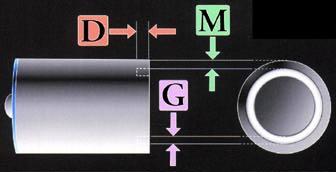
The TWC or Target Wadcutter can be ordered with Base Guard(tm), hollow, cup, dish, flat or RBT base. It is generally preferred for international pistol matches in 32 caliber, and with other firearms which do not feed well with anything but a flat profile nose. It is highly accurate for short to medium ranges at subsonic velocity, especially with a hollow base or cup base design. Top of Page | ||||||||||||||||||||||||||||||||||||||||||||||||||||||||||||||||||||||||||||||||||||||||||||||||||||
Button Nose Wadcutter BWC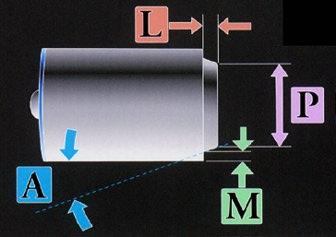
The button nose wadcutter is preferred for most US revolvers and autoloaders used for indoor and 20-ft to 50-yd target shooting. It cuts a clean hole in the paper, and is very accurate at sub-sonic speeds. The base can be hollow, cup, dish, flat, Base Guard(tm), or rebated boattail. Most commonly it is BG, hollow, cup or flat. Top of Page | ||||||||||||||||||||||||||||||||||||||||||||||||||||||||||||||||||||||||||||||||||||||||||||||||||||
Keith SWC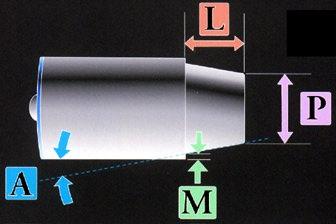
The Keith semi-wadcutter nose is a special case of the truncated conical nose. It has a more shallow angle, and a broader meplat, which is ideally suited for revolvers. The TC or a modified version called the "AL" or autoloader shape (with radius edges and rounded meplat) may feed better in magazine pistols. The Keith nose was designed and named after famous pistol shooter Elmer Keith, who is closely associated with the development and commercial popularity of the .44 Magnum. Top of Page | ||||||||||||||||||||||||||||||||||||||||||||||||||||||||||||||||||||||||||||||||||||||||||||||||||||
Truncated Cone TC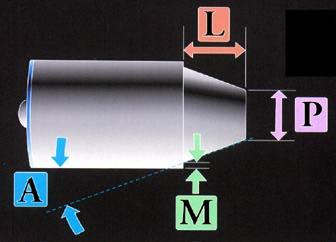
The truncated cone is a longer form of the famous Keith nose, which is in turn a special case of the TC. Truncated conical bullets are often used in revolvers and autoloaders. Magazine fed pistols seem to prefer the TC over the Keith in feeding reliability. All standard base shapes can be used with this nose. Most commonly the BG, cup or flat base is used. | ||||||||||||||||||||||||||||||||||||||||||||||||||||||||||||||||||||||||||||||||||||||||||||||||||||
Conical Nose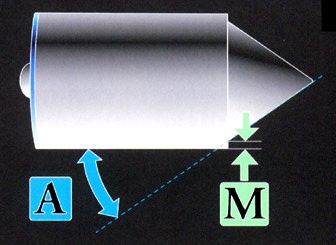
The conical nose was found on the Remington "Highway Patrol" bullets in .357 Magnum, and can be used with any caliber where a short nose and light weight is desired. Mistakenly called "armour piercing" this shape does tend to concentrate initial force in one spot, but soft lead tips quickly flatten and spread the energy. The shape is somewhat more aerodynamic than a truncated cone and in theory would drop less at longer ranges. Top of Page | ||||||||||||||||||||||||||||||||||||||||||||||||||||||||||||||||||||||||||||||||||||||||||||||||||||
Rebated Boattail Base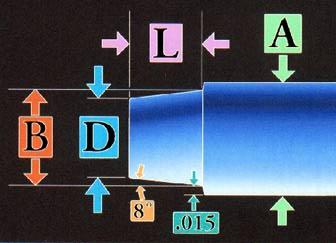
The RBT or Rebated Boattail has a rebate or step joining the base conic section to the shank. The step breaks up the flow of muzzle gas as the bullet emerges from the barrel, acting as a spoiler to prevent the gas from following the outline of the bullet and finally breaking up as a ball of gas through which the bullet must pass. Instead, the gas is deflected by the sharp edge into an expanding ring of gas with a clear space in the center, which can reduce the dispersion of the bullet by up to 15 percent compared to a regular boattail base. Top of Page | ||||||||||||||||||||||||||||||||||||||||||||||||||||||||||||||||||||||||||||||||||||||||||||||||||||
Elliptical Nose Shapes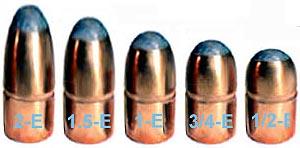 Elliptical nose shapes are designated with "E" numbers, which simply refer to the length of the ogive, along the center axis, in calibers. A .458 bullet with a 1-E ogive has a nose length of .458 inches. A .458 with a 1/2-E nose has a perfectly round nose, because the length is half the caliber, which is the radius of a circle that just fits inside the caliber. The elliptical nose normally is tangent to the shank, but the curve is not of one constant radius. Rather, the radius constantly changes along the curve. An ellipse can be drawn with two focal points, whereas a spitzer curve is a segment of a circle with only one focal point at the center. A spitzer (or tangential ogive) curve crosses the centerline at an angle other than 90-degrees, whereas an elliptical nose only crosses the centerline at 90-degrees. These are some of the characteristics of the elliptical nose shape. The most typical rifle nose shape for round nose bullets is the 1-E curve. The most typical pistol nose shape for round nose bullets is the 3/4-E curve. Although the 1.5 and 2-E curve are sometimes used in Ely-Kynoch big game bullets, in order to produce a curve that clears the rifling so that a long heavy bullet will not jam the rifle (typically used for hunting dangerous game), a dual-diameter bullet with a bore-riding forward section is even more effective and allows the use of any desired ogive. Elliptical curves longer than 1-E usually are restricted to the heaviest weight bullets of a given caliber, and are not suitable for pistol bullets. 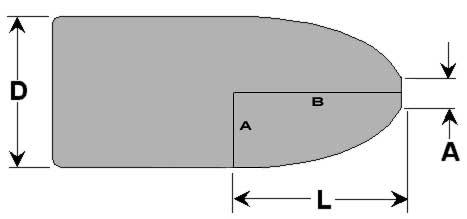 The two standard shapes for Corbin swage dies are the 1-E (normal rifle and long, heavy pistol) and the 3/4-E (normal pistol and short rifle). In the 600 Nitro Express and similar big bore, turn-of-the-century bullets, the 1/2-E or true round nose is standard. The 9.3 Makarov Pistol also uses a true 1/2-E round nose, but the Corbin standard shape for Makarov bullets is a more efficient 3/4-E shape (which feeds as well or better). SWC-type bullets with a shoulder can use 3/4-E or 1-E noses, also. But it is usually a mistake to try to use 1.5 or 2-E noses in a SWC punch cavity, because the long, deep cavity tends to trap air and the nearly parallel sides of the cavity tend to make the bullet hard to remove without excess lube (which in turn prevents the tip from filling out completely). The two standard shapes for Corbin swage dies are the 1-E (normal rifle and long, heavy pistol) and the 3/4-E (normal pistol and short rifle). In the 600 Nitro Express and similar big bore, turn-of-the-century bullets, the 1/2-E or true round nose is standard. The 9.3 Makarov Pistol also uses a true 1/2-E round nose, but the Corbin standard shape for Makarov bullets is a more efficient 3/4-E shape (which feeds as well or better). SWC-type bullets with a shoulder can use 3/4-E or 1-E noses, also. But it is usually a mistake to try to use 1.5 or 2-E noses in a SWC punch cavity, because the long, deep cavity tends to trap air and the nearly parallel sides of the cavity tend to make the bullet hard to remove without excess lube (which in turn prevents the tip from filling out completely).Such orders are produced with a warning, against Corbin's recommendations. They sometimes work well, but not always. A concept that worked once or twice for someone may not be reliable enough, in all calibers and in all circumstances, to be warrantied as working every time. Corbin builds custom tooling to order, and the person who orders custom work owns the die and the results of that design. The usual liberal warranty does not apply to items that are not standard design and practice, based on long experience. We already know that some things may cause problems, and that is why we do not recommend them. But that doesn't mean you can't have them, if you want to take the chance. Lots of things that don't work all the time may work fine for one person in one circumstance. Just remember that may work also implies might not work. The 1-E and 3/4-E will work. Top of Page | ||||||||||||||||||||||||||||||||||||||||||||||||||||||||||||||||||||||||||||||||||||||||||||||||||||
Spitzer Nose Shapes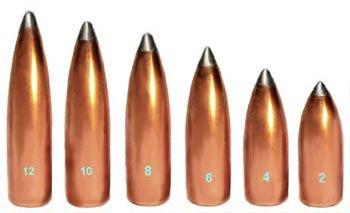 The spitzer or tangential ogive is described by drawing two arcs of equal radius, starting 1/2 caliber from the centerline on line perpindicular to the centerline, and ending when the arc crosses the centerline. The S-number is the number of times to multiple the caliber, in order to determine the radius of this arc. 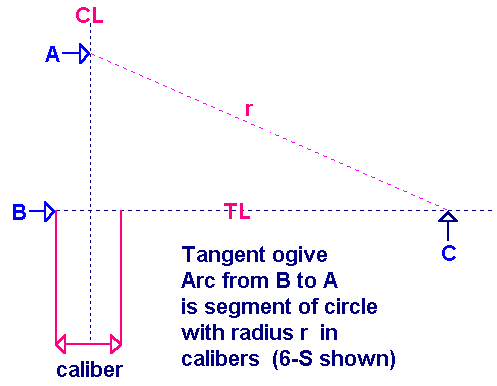 This method of designating a nose curve means that regardless of caliber, the appearance will be the same in proportion to caliber. A 512 caliber bullet with a 6-S ogive looks like an enlarged .172 caliber bullet with the same 6-S ogive. The smallest possible S number is 0.5 (1/2). If the radius of the nose curve is half the caliber, then the full nose is half a circle, starting and ending tangent to the bullet shank. (Tangent means in line with, or at exactly zero or 180 degrees on the compass scale.) Any curve that intercepts the bullet shank at any other angle is a secant ogive. Secant ogives cannot be defined only by their curve radius, because obviously you can intercept the shank at many angles, and use more or less of the arc from the point where it crosses the centerline. The most common tangent ogive or spitzer (German for "sharp") ogive is the 6-S. In a .224 caliber, a 6-S ogive has a radius of 1.344 inches. The length along the axis of the bullet depends on the meplat or diameter of the tip. If the tip is the same diameter as the shank, you have no ogive at all (a straight cylinder) and a zero length therefore, no matter what radius of ogive in theory is used. As you make the tip smaller, the ogive that is allowed to exist becomes longer, until you reach the theoretical maximum length at the point where there is zero width of tip (a needle-sharp spitzer full jacket or lead tip). Most open tip bullets have a tip meplat of from .060 to .120 inch diameter, the most common being about .080. 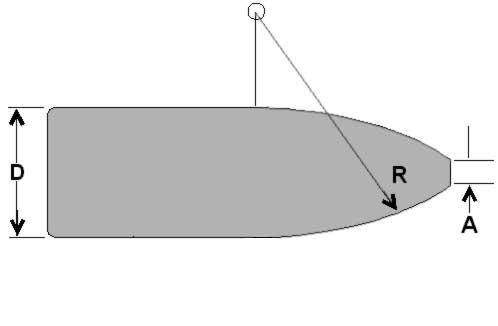 Corbin offers standard spitzer shapes of 6-S in all calibers up to .358. From .358 and larger, this makes a rather heavy bullet, so the 4-S becomes more common. The 50 BMG is an exceptionally long and heavy bullet, and again the 6-S ogive becomes standard. Corbin can make any ogive radius, but typically the 2-S and 4-S are used for the larger calibers in .375 to .458, and the 6-S, 8-S, or 10-S is used in smaller sizes. The more blunt the nose, the wider is the possible range of weights. A short nose allows the same length of bullet to have more shank, for heavier maximums in practical length limits. It also allows the bullet to have a shorter shank (down to the length of the nose) and still remain balanced. A 10-S ogive, for example, would mean a light bullet would be almost entirely consumed by the ogive, with little or no shank left, and a heavy bullet would become too long for many actions or chambers because the long thin nose section doesn't hold as much volume of lead as a blunt nose plus the balance of length in full caliber shank. Corbin offers standard spitzer shapes of 6-S in all calibers up to .358. From .358 and larger, this makes a rather heavy bullet, so the 4-S becomes more common. The 50 BMG is an exceptionally long and heavy bullet, and again the 6-S ogive becomes standard. Corbin can make any ogive radius, but typically the 2-S and 4-S are used for the larger calibers in .375 to .458, and the 6-S, 8-S, or 10-S is used in smaller sizes. The more blunt the nose, the wider is the possible range of weights. A short nose allows the same length of bullet to have more shank, for heavier maximums in practical length limits. It also allows the bullet to have a shorter shank (down to the length of the nose) and still remain balanced. A 10-S ogive, for example, would mean a light bullet would be almost entirely consumed by the ogive, with little or no shank left, and a heavy bullet would become too long for many actions or chambers because the long thin nose section doesn't hold as much volume of lead as a blunt nose plus the balance of length in full caliber shank.Top of Page | ||||||||||||||||||||||||||||||||||||||||||||||||||||||||||||||||||||||||||||||||||||||||||||||||||||
Semi-Wadcutter Noses Standard SWC nose shapes from left to right: Target Wadcutter (TWC), Button Nose Wadcutter (BWC), Conical, Keith, Auto-Loader (AL), 3/4-E round nose, 1-E round nose. These can be made without jacket in the LSWC-1 die, or with jacket as shown in the JSCW-2 two-die set (core swage and core seat). The nose is formed in a punch cavity, so you can change one punch to change the nose shape. Bullet Design Page |
Start writing here...
Standard Bullet Specs